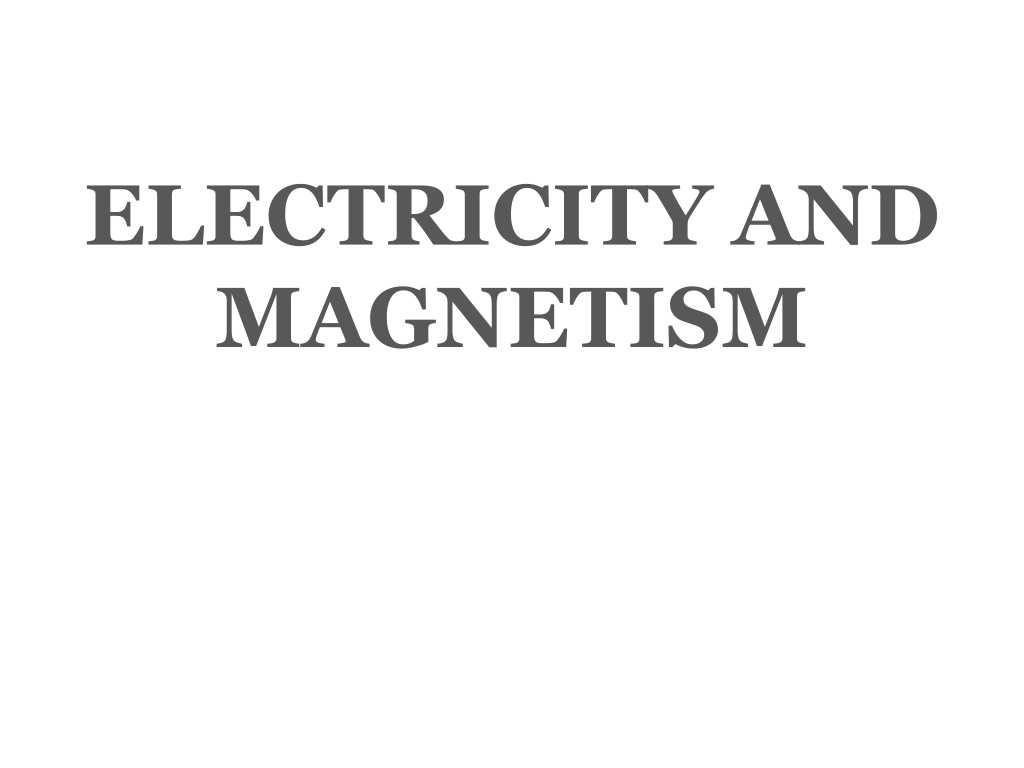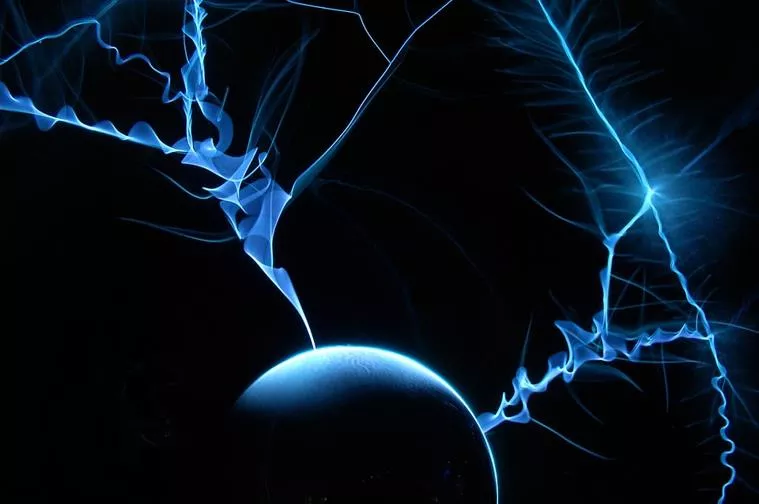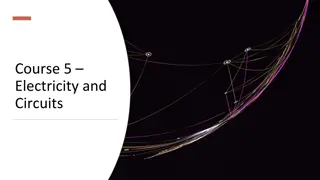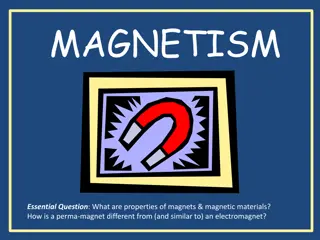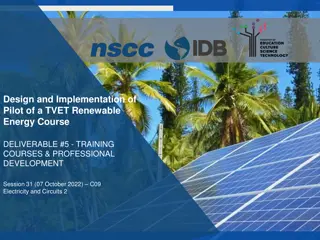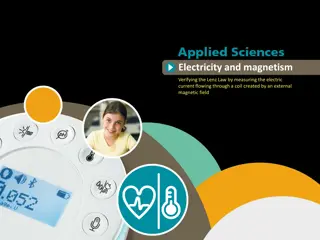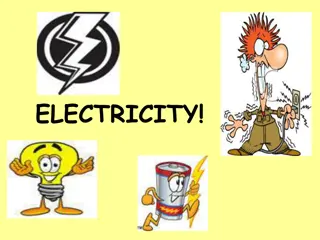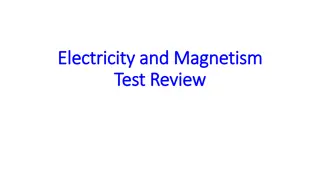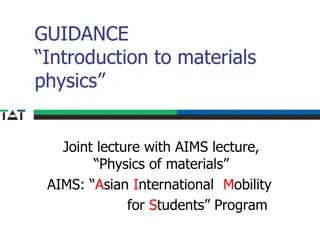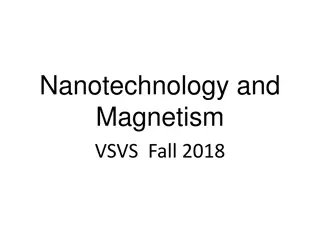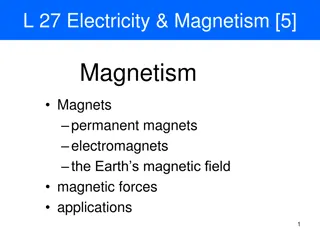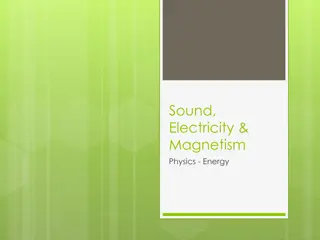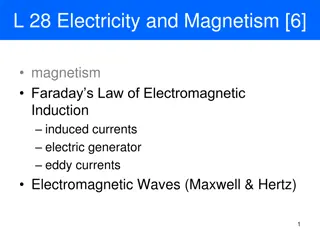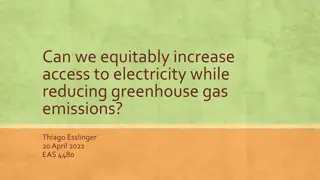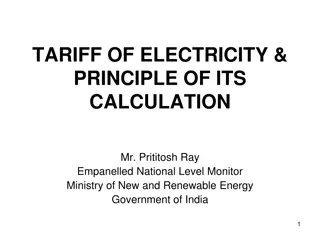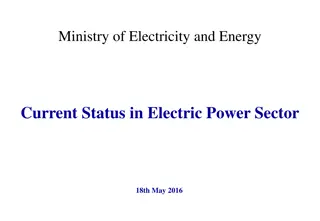Electricity and Magnetism Overview
Electricity and magnetism are essential in our daily lives, powering our homes and technologies. Discover the history of electricity, its properties, and the fundamental concepts of charges. Explore how inventors like Michael Faraday and Thomas Edison revolutionized the use of electricity.
Download Presentation

Please find below an Image/Link to download the presentation.
The content on the website is provided AS IS for your information and personal use only. It may not be sold, licensed, or shared on other websites without obtaining consent from the author.If you encounter any issues during the download, it is possible that the publisher has removed the file from their server.
You are allowed to download the files provided on this website for personal or commercial use, subject to the condition that they are used lawfully. All files are the property of their respective owners.
The content on the website is provided AS IS for your information and personal use only. It may not be sold, licensed, or shared on other websites without obtaining consent from the author.
E N D
Presentation Transcript
ELECTRICITY AND MAGNETISM
I. What is Electricity? A. We use electricity every day. Our homes, stores, and workplaces depend on electricity. B. Electricity usually means the flow of something called electric current in wires, motors, light bulbs, and other devices. C. Electric current flows through solid metal so we can t usually see it.
I. What is Electricity? D. Electric current can carry energy over great distances. That s why you can have an electric company hundreds of miles away from your house and still have electricity. E. Electric current can be very powerful. An electric motor the size of a basketball can do as much work as 15 strong men or women. This great power can also be very dangerous.
II. History of Electricity A. The understanding and use of electricity is relatively recent history. In 1733, French scientist Charles DuFay published a book describing how like charges repel and opposite charges attract. B. DuFay theorized that there were two fluids that caused electricity - a positive fluid and a negative fluid.
II. History of Electricity C. Later in the 1700 s, Benjamin Franklin invented his own theory that electricity is the presence of a single fluid in different amounts. Franklin thought if there was too much of this electric fluid in an object, it would have a positive charge. Not enough of this electric fluid and an object would have a negative charge.
II. History of Electricity D. In the 1800 s, inventors and scientists began to harness the power of electricity. E. Michael Faraday discovered the principles of the electric motor in 1830, and Thomas Edison invented the light bulb in 1879.
Charges Charges come in 3 main forms; Objects can be positive, negative, or neutral. 1. Positive - A positive object has lost electrons, so it has more protons than electrons. 2. Negative - A negative object has gained electrons, so it has more electrons than protons. 3. Neutral - A neutral (No charge) object has an equal amount of protons and electrons. The unit of charge is the coulomb (C).
III. Charge A. To understand electricity, people first studied events like lightning and the sparks that can occur with static electricity. B. The source of the shock and the sparks from static electricity is electric charge. Electric charge is a fundamental property of matter.
III. Charge C. Charge comes in two forms - positive and negative charge. D. Like charges repel each other, and unlike charges attract. That means that a positive charge and a positive charge will push away from each other. The same thing happens with a negative charge and a negative charge. A positive and a negative charge will come together.
III. Charge E. The forces between positive and negative charges are called electrostatic forces. Electrostatic forces are extremely strong - electrostatic forces hold all matter together. F. Most matter is electrically neutral - The amount of positive charge in an object is exactly equal to the amount of negative charge in an object. The total charge is zero.
III. Charge G. The unit of charge is the coulomb- it is abbreviated C. H. The protons in an atom carry a positive charge and the electrons in an atom carry a negative charge.
In an atom, protons are held together in the nucleus by strong nuclear forces, but electrons are free to move around. Electricity is caused by moving electrons. Electricity comes from electrons moving between atoms. NOT PROTONS!!!
Electric charges are from protons which are positive and electrons which are negative + . - Atoms become charged by gaining or losing electrons.
Law of Conservation of Charge electric charges can be transferred from object to object, but it cannot be created or destroyed. Positive and negative charges exert forces on each other. - + + + - - opposite charges attract like charges repel
Static Electricity accumulation of excess electric charges on an object *When you rub your socks on the carpet electrons are flowing from the ground to your socks building up static electricity.* Static Discharge - is the release or balancing effect of excess charges that have accumulated on an object. *When you touch or Shock someone, you are discharging that accumulation of charge.* Lightning is static discharge on a 100x level.
I. Voltage A. Review - Remember that a circuit is something that provides a path through which energy in the form of electricity moves. B. A circuit contains several parts - an energy source, wires, and sometimes switches or things that use energy, like light bulbs. *Pushes Electricity through a circuit.
I. Voltage C. We can measure the energy level of any place in a circuit. To measure electrical energy, we use a unit called volts. D. Voltage is related to potential energy, just like height is related to pressure in water flow.
I. Voltage E. Imagine you have two tanks of water, one is higher than the other. The higher tank has more potential energy than the lower tank. The water flows downhill, from high energy to low energy. A greater difference in height means that the water has more potential energy. F. The two water tank scenario is just like a difference in voltage. Electricity flows from an area of higher voltage to an area of lower voltage.
I. Voltage G.Voltage is a measure of energy. The voltage of a circuit will not change unless there is something on the circuit that uses energy, like a light bulb. F. Anything that uses energy lowers the voltage of a circuit since it takes energy away from any moving charges in the circuit.
II. Current A. In a circuit, energy flows from places of high voltage to places of low voltage. Electrical current is the term used to describe this flow of energy. B. Current is actually the flow of negative charges through a circuit. Current can be thought of as how much charges flows through a wire per second.
II. Current C. The unit for current is the ampere. An ampere, or amp, is a flow of one coulomb per second. Remember that coulomb is the unit for charge, so an amp is one charge moving through a wire per second. D. For example, a current of 10 amps means that 10 coulombs of charge flow through the wire every second.
II. Current E. When you look at a wire, you can t see current. The particles that carry charge are electrons. Electrons are the negatively charged part of atoms, and they are so small that they can flow in the spaces between atoms.
II. Current F. Current occurs in a circuit with a battery because electrons in the battery repel electrons in the wire, which repel other electrons in the wire, and so on. G. Remember: A voltage difference supplies energy to make charges flow. Current carries energy and does work
III. Current in Your Home A. You use electric current in your house every day. When you plug in an electrical appliance, you connect it to a circuit created by wires in the walls. The wires eventually connect to power lines outside your house that brings the current from a power station.
III. Current in Your Home B. The electricity in your house uses alternating current, or AC current. This means the direction of current goes back and forth. In electrical systems in the US, the current reverses direction 60 times per second. In Europe, the AC current reverses direction only 50 times per second, and the voltage is different, so adapters are needed for electric devices made in the US.
III. Current in Your Home C. Each wall socket you see in your house has three holes - and each hole has a wire attached to it inside the wall. One wire is the hot wire, which carries 120 Volts AC. The second wire stays neutral and carries no volts. The third wire is a ground wire which is connected to the actual ground near your home - if there is a short circuit in your appliance, the current will flow through the ground wire instead of through you!
III. Current in Your Home D. The current from a battery does not alternate. A battery only makes current that flows in one direction. This is called direct current, or DC current. E. For all large amounts of electricity, AC current is used because it is easier to transmit and generate.
IV. Conduction and Resistance A. Charge flows very easily through some kinds of materials, like copper. Material that easily conducts, or carries, electrical current is called a conductor. B. Other materials, like glass or plastic, do not allow charge to flow. These materials are called insulators because they insulate or block the flow of current.
IV. Conduction and Resistance C. A third category of materials are not as easy- flowing for current as conductors, but they are not quite insulators either. These materials are named semiconductors. Semiconductors are very important for computer chips.
V. Conduction A. The property of a material to allow charge to flow is called its electrical conductivity. All materials have some degree of conductivity - those with high conductivity are conductors. Materials with low conductivity are insulators.
V. Conduction B. Examples of conductors include silver, copper, gold, aluminum, and tungsten. C. Examples of insulators include rubber, paper, plastics, and glass.
VI. Resistance A. The resistance of an object measures how difficult it is for charges to flow through something. High resistance means it is difficult for current to flow. Low resistance means it is easy for current to flow. B. Devices that use electrical energy have resistance. For example, light bulbs have resistance. If you string more light bulbs together, the resistance adds up and the current goes down.
VI. Resistance C. Electrical resistance is measured in units called ohms. The unit is abbreviated with the Greek letter omega ( ). D. Voltage and resistance together determine how much current flows in a circuit. If voltage goes up, current goes up. If resistance goes up, current goes down.
Electric Current net movement or flow of charges in a single direction through a wire or conductor. Potential Difference (Voltage) force that causes electric charges to flow; charges flow from high voltage low voltage Resistance tendency for a material to oppose the flow of electrons, changing electrical energy into thermal and light energy.
Circuit a closed path that electric current follows. Battery, wires, and voltage difference allows current to flow.
BATTERIES Dry Cell Chemical reactions occur in a moist paste causing transfer of electrons Wet Cell Contains two connected plates made of different metals in conducting solution. Ex. Car Battery
Making wires thinner, longer or hotter increases resistance All materials have some electrical resistance measured in ohms. ( ) Ohms Law current in a circuit equals Potential difference (Voltage) divided by resistance. Potential diff Current = Resistance
VII. Summary A. Voltage is a measure of energy of a system. Energy flows anytime there is a voltage difference. Current flows from high voltage to low voltage. B. Current is a measure of how many charges flow through a circuit per second. Current is measured in Amperes, or amps.
VII. Summary C. Materials that easily carry charge are called conductors. D. Materials that resist carrying charge are called resistors.
I. Review 1. We have covered three important electrical qualities so far voltage, current, and resistance. 1. Remember that voltage is a measure of the energy level of a system. Any time there is a voltage difference a current flows. Voltage is measured in volts.
II. Review 1. Current is a measure of how many charges flow through a circuit per second. The unit for current is amps. 1. Resistance is a measure of how difficult it is for current to flow. The unit for resistance is the ohm.
III. How it all fits together 1. Voltage, current, and resistance are all related. If you increase the voltage of a circuit, the current goes up. If you increase the resistance of a circuit, the current goes down.
III. How it all fits together B. The relationship between voltage, current, and resistance can be summarized in a mathematical relationship called Ohm s law: V Voltage (Volts) Current = Resistance (Amps) I R (Ohm s) Where I is current in amps, V is voltage in volts, and R is resistance in ohms
IV. Ohms Law A. You can manipulate ohm s law to find either current, voltage, or resistance of a circuit if you know any two of the three components in a circuit. B. To find voltage of a circuit, use V = I x R C. To find resistance of a circuit, use R = V/I
IV. Ohms Law D. Lets try some problems: What is the voltage of a circuit that has a current of 20 amps and resistance of 5 ohms? A: Voltage G: Current, resistance E: V = I x R S: V = 20 x 5 U: Volts Answer:________
IV. Ohms Law E. What is the current of a circuit that has voltage of 100 volts and resistance of 5 ohms? A: Current G: Volts, resistance E: I = V/R S: I = 100/5 U: Amps Answer:________
IV. Ohms Law F. What is the resistance of a circuit that has a voltage of 20 volts and a current of 5 amps? A: Resistance G: Voltage, Current E: R = V/I S: R = 20/5 U: Ohms Answer:________
